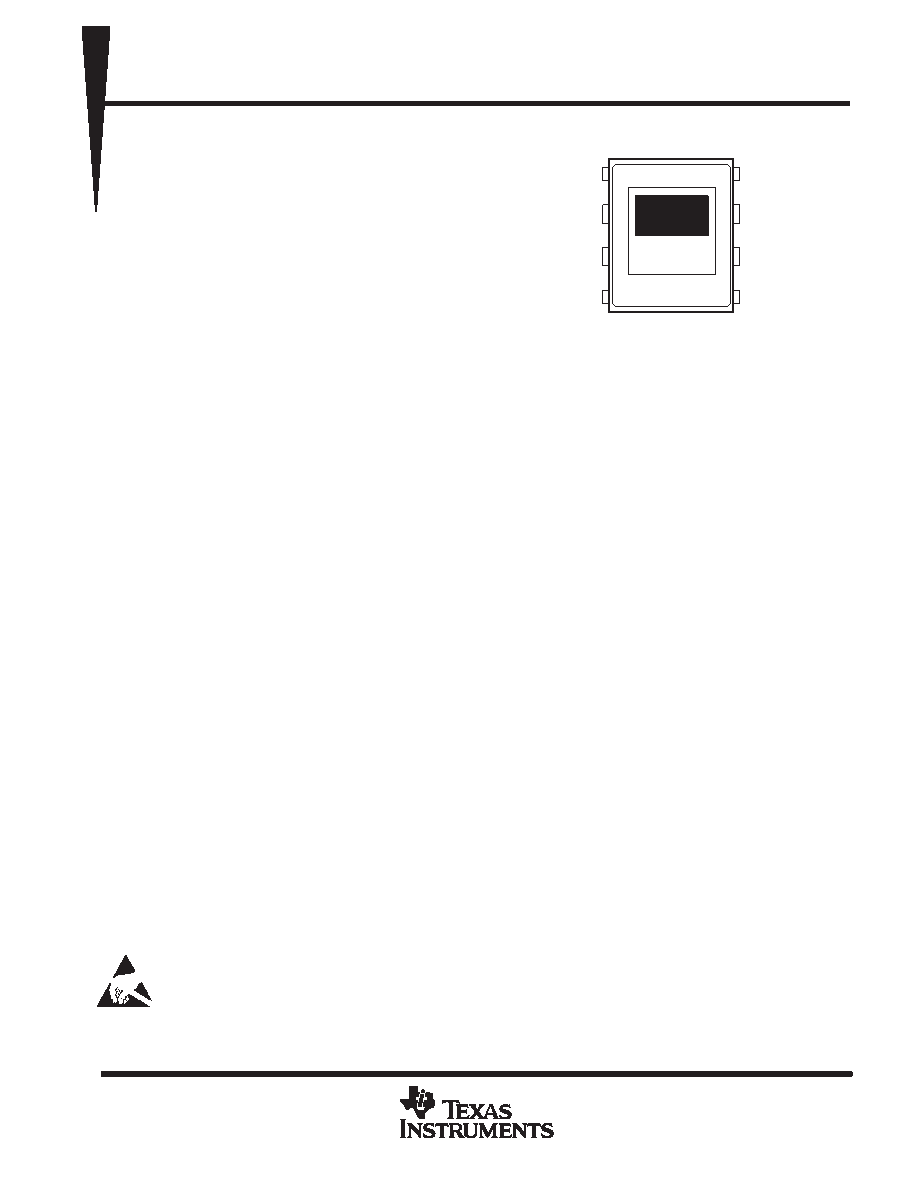- 您現(xiàn)在的位置:買(mǎi)賣(mài)IC網(wǎng) > PDF目錄98169 > TC255 (TEXAS INSTRUMENTS INC) SPECIALTY ANALOG CIRCUIT, CDIP8 PDF資料下載
參數(shù)資料
| 型號(hào): | TC255 |
| 廠商: | TEXAS INSTRUMENTS INC |
| 元件分類(lèi): | 模擬信號(hào)調(diào)理 |
| 英文描述: | SPECIALTY ANALOG CIRCUIT, CDIP8 |
| 封裝: | 2.54 MM PITCH, WINDOWED, CERAMIC, DIP-8 |
| 文件頁(yè)數(shù): | 1/18頁(yè) |
| 文件大小: | 242K |
| 代理商: | TC255 |
當(dāng)前第1頁(yè)第2頁(yè)第3頁(yè)第4頁(yè)第5頁(yè)第6頁(yè)第7頁(yè)第8頁(yè)第9頁(yè)第10頁(yè)第11頁(yè)第12頁(yè)第13頁(yè)第14頁(yè)第15頁(yè)第16頁(yè)第17頁(yè)第18頁(yè)

TC255
336-
× 244-PIXEL CCD IMAGE SENSOR
SOCS034C – FEBRUARY 1993 – REVISED NOVEMBER 1994
Copyright
1994, Texas Instruments Incorporated
1
POST OFFICE BOX 655303
DALLAS, TEXAS 75265
Medium-Resolution, Solid-State Image
Sensor for Low-Cost B/W TV Applications
324(H) x 243(V) Active Elements in
Image-Sensing Area
10-m Square Pixels
Small Size
Low Cost
Fast Clear Capability
Electronic-Shutter Function From
1/60–1/50000 s
Low Dark Current
Electron-Hole Recombination Antiblooming
Dynamic Range...66 dB Typical
High Sensitivity
High Blue Response
8-Pin Dual-In-Line Ceramic Package
4-mm Image-Area Diagonal
Solid-State Reliability With No Image
Burn-In, Residual Imaging, Image
Distortion, Image Lag, or Microphonics
description
The TC255 is a frame-transfer charge-coupled device (CCD) designed for use in B/W NTSC TV and
special-purpose applications where low cost and small size are desired.
The image-sensing area of the TC255 is configured in 243 lines with 336 elements in each line. Twelve elements
are provided in each line for dark reference. The blooming-protection feature of the sensor is based on
recombining excess charge with charge of opposite polarity in the substrate. This antiblooming is activated by
supplying clocking pulses to the antiblooming gate, an integral part of each image-sensing element.
The sensor can be operated in a noninterlace mode as a 324(H) by 243(V) sensor with very low dark current.
The device can also be operated in an interlace mode, electronically displacing the image-sensing elements
during the charge integration in alternate fields, effectively increasing vertical resolution and minimizing aliasing.
One important aspect of this image sensor is its high-speed image-transfer capability. This capability allows for
an electronic-shutter function comparable to interline-transfer and frame-interline-transfer sensors without the
loss of sensitivity and resolution inherent in those technologies.
The charge is converted to signal voltage with a 12-
V per-electron conversion factor by a high-performance
charge-detection structure with built-in automatic reset and a voltage-reference generator. The signal is
buffered by a low-noise two-stage source-follower amplifier to provide high output-drive capability.
The TC255 is built using TI-proprietary virtual-phase technology, which provides devices with high blue
response, low dark signal, good uniformity, and single-phase clocking. The TC255 is characterized for operation
from –10
°C to 45°C.
This device contains circuits to protect its inputs and outputs against damage due to high static voltages or electrostatic fields. These
circuits have been qualified to protect this device against electrostatic discharges (ESD) of up to 2 kV according to MIL-STD-883C,
Method 3015; however, it is advised that precautions be taken to avoid application of any voltage higher than maximum-rated voltages
to these high-impedance circuits. During storage or handling, the device leads should be shorted together or the device should be
placed in conductive foam. In a circuit, unused inputs should always be connected to an appropriated logic voltage level, preferably either VCC
or ground. Specific guidelines for handling devices of this type are contained in the publication
Guidelines for Handling
Electrostatic-Discharge-Sensitive (ESDS) Devices and Assemblies available from Texas Instruments.
DUAL-IN-LINE PACKAGE
(TOP VIEW)
IAG2
ADB
SUB
OUT
ABG
IAG1
SAG
SRG
1
2
3
4
8
7
6
5
PRODUCTION DATA information is current as of publication date.
Products conform to specifications per the terms of Texas Instruments
standard warranty. Production processing does not necessarily include
testing of all parameters.
相關(guān)PDF資料 |
PDF描述 |
|---|---|
| TC2574-VOETR | 1.8 A SWITCHING REGULATOR, 63 kHz SWITCHING FREQ-MAX, PDSO16 |
| TC2575-12.0VAT | 3.2 A SWITCHING REGULATOR, 63 kHz SWITCHING FREQ-MAX, PSFM5 |
| TC271-40 | SPECIALTY ANALOG CIRCUIT, CDIP22 |
| TC33025VOETR | 2 A SWITCHING CONTROLLER, 1000 kHz SWITCHING FREQ-MAX, PDSO16 |
| TC33163EOETR | 3.4 A SWITCHING CONTROLLER, 55 kHz SWITCHING FREQ-MAX, PDSO16 |
相關(guān)代理商/技術(shù)參數(shù) |
參數(shù)描述 |
|---|---|
| TC2550 | 功能描述:鋁質(zhì)電解電容器 - 帶引線 5000uF 25Volts RoHS:否 制造商:Kemet 引線類(lèi)型: 電容:220 uF 容差:20 % 電壓額定值:25 V 工作溫度范圍: 端接類(lèi)型:Radial 外殼直徑:8 mm 外殼長(zhǎng)度:11 mm 引線間隔:5 mm 產(chǎn)品:General Purpose Electrolytic Capacitors 封裝:Bulk |
| TC255P | 制造商:Texas Instruments 功能描述:IMAGE SENSOR B/W CCD 336X244PIXELS 8PDIP - Bulk |
| TC2571 | 制造商:TRANSCOM 制造商全稱(chēng):TRANSCOM 功能描述:1 W Low-Cost Packaged PHEMT GaAs Power FETs |
| TC2574 | 制造商:TELCOM 制造商全稱(chēng):TelCom Semiconductor, Inc 功能描述:0.5A Step-Down Switching Regulator |
| TC2574-12.0VPA | 制造商:Rochester Electronics LLC 功能描述:- Bulk |
發(fā)布緊急采購(gòu),3分鐘左右您將得到回復(fù)。
